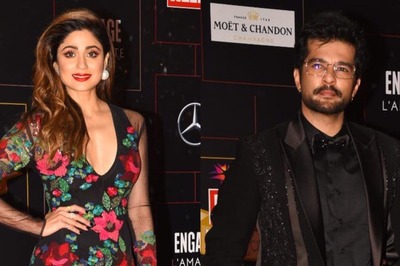
views
As the debate on electoral reforms gathers momentum, thanks to the latest verdicts delivered by the apex court, be it in the case of disqualification of convicted legislators or bringing political parties under the ambit of the RTI Act, some commentators and NGOs are now arguing that the FPTP (first past the post) system of conducting elections to both the state and the central legislature, which notwithstanding its colonial legacy , was consciously adopted by our founding fathers in the Constituent Assembly, should be replaced by the PR (proportional representation) system, which is widespread throughout Europe and adopted by 57 out of 150 countries worldwide. Given the fact that even the 170th Law Commission Report discussed this idea, it would be gain worthy for us to analyse, if indeed the PR system presents itself as a more efficacious and virtuous system on the counts of infusing greater representational character, fairness and political stability into our admittedly fractured, opaque and disconnected political system.
To begin with, we must understand why the demand for the PR system has come about.
The FPTP system , prevalent in 43 countries including the United Kingdom, Canada, India, the United States, and many Commonwealth states , is more like a winner-takes-all arrangement, where a candidate wins the constituency , even if he secures just one vote more than his other rival(s). It isn't necessary that the winner should have secured a majority of the votes cast. No wonder then, that increasingly we do see candidates winning their seats, despite not securing even 15% of the popular vote or if you see it in another way- a candidate wins his seat despite the fact that 85% of his voters don't support him! Now, in a democracy it would be patently unfair that votes cast against a "winning" candidate are wasted or disregarded, particularly when they happen to be numerically greater than the votes actually cast in his favour! After all, the concept of One Man-One Vote, in a deeper sense signifies that every vote should count; irrespective of what result that vote may bring to its recipient. To remove this unfairness, the PR system recommends allocation of seats in proportion to the votes secured by a party. So, if party X secured 30% vote and party Y got 49% of the total popular vote, they would be entitled to 30 and 49 seats respectively in a house of 100. So the PR system, in one way can ensure that every vote counts. But does that mean the PR system is more representative in character than the FPTP system? Well when it comes to making every vote count, perhaps yes. A word of caution must be put here - some countries which have adopted the PR system put a condition to the effect that a party must secure at least 5% of the national vote to be eligible for a seat in the legislature. Why the threshold is 5% and not 2% or 3% you ask? Well, your guess is as good as mine! It's arbitrary! All I'm trying to say is that, in such a scenario, even the PR system ends up creating an artificial distinction between categories of votes much like its cousin, the FPTP system.
The other parameter of testing representational character of an election would be from the candidate-constituency connect paradigm. Now, this is where the opponents argue that in the PR system one votes, not for a candidate but for a party. For eg: In a closed list PR system it's the party that would have the right to decide who to appoint as a representative on the seats that it wins , based on a pre-decided priority. Given that we have little inner-party democracy and given the highly centralised nature of our political parties, this system would surely not be as representative as we'd want it to be. An open list PR system, where voters get to choose the candidate from a list of potential candidates, rather than the party, is a better system, as candidates securing the most votes would have an automatic priority in being nominated to the seats won by the party. But again, the open list system too would not necessarily establish the much needed candidate-constituent connect to the degree that the FPTP system theoretically professes to establish.
However, let us also examine how well this link in the FPTP system is working in practice. Now consider this- In the Indian general elections held in 1999, 2004, and 2009, the percentage of winning candidates securing less than 50% of the vote was 60.03, 75.87 and 82.68 % respectively. Increasingly, the trend reflects, that a major chunk of winning candidates may be victors but not necessarily representatives of the overall mood of the constituency they are elected from. So, this flies right in the face of the argument made by pro-FPTP supporters, who suggest that the candidate-constituent connect, vital for the success of representative democracy, gives an edge to this system over the PR system. In reality, this crucial candidate-constituent connect isn't as vibrant as we think it is in the FPTP system either and practically the candidate only represents a shade of a majoritarian interest in the constituency and not a sum total of the entire interest. Clearly, both systems leave much to be desired on the representational character front.
Now, let us test both systems on the anvil on fairness. My first parameter of fairness is partly a function of the representational character argument, being extended to socio-moral perspective. We all want women or let's say minorities, in proportion to their population, to be represented in legislatures. (I won't extend the argument to Scheduled Castes as they have seats reserved for them specifically to achieve this goal) . Has the FPTP system helped us achieve that? I'm afraid not. If we consider the lower house of Parliament, not a single Lok Sabha to date has managed to ensure that even 20% it's strength consists of women although they comprise almost 48% of the population. In fact, women are grossly under-represented and currently their membership hovers at 10.7% of the 15th Lok Sabha. Now, whether the PR system could remedy this situation of demographic distortion?
If we went by the findings of this study by Pippa Norris from Harvard University, the answer seems to be yes but a conditional yes, mind you. The study quotes "One central virtue of proportional systems is the claim that they are more likely to produce a parliament, which reflects the composition of the electorate.The main reason is that parties may have an incentive to produce a 'balanced' ticket to maximize their support where they have to present a party list, whereas in contrast there is no such incentive where candidates are selected for single-member districts. (i.e. where FPTP system is practiced). Moreover measures of affirmative action within party recruitment processes can be implemented more easily in systems with party lists." The study further adds "Based on the proportion of women in the lower house in the mid-nineties the results confirm that women are better represented in proportional systems. Women were 7.3 percent of MPs in majoritarian systems and 17.2 percent of members in PR systems. Of course again the pattern was not linear and more women were elected in some majoritarian systems like Canada than in other countries like Israel using highly proportional systems." But my understanding is that this ideal of ensuring that the legislature represents the demographic make up , will require inner party democracy and affirmative action and doesn't just depend on whether we adopt a PR system or FPTP system.
Yet another test of fairness of an electoral system would be its propensity to reward seats in equal proportion to the vote secured by a party. Under the FPTP system, the disproportionate relationship provides a winner's bonus for the party in first place, while penalising others. Eg: In the UP elections of 2012 , the Samajwadi Party won over 50% seats by securing just 30% of the vote whereas the Bahujan Samajwadi Party which secured 26% vote won just 20% of the seats in the UP assembly. A mere 4% vote share difference gave SP an edge of a massive 146 seats in a House of 403 seats! Now, there have been elections under FPTP system where the vote secured is proportional to the seats won but studies suggest that the average winner's bonus under FPTP systems is 12.5 % points, compared with 5.7 % under proportional representation. Hence, under FPTP systems a party which wins 37.5 percent of the vote or more could usually be assured of a parliamentary majority, whereas under PR systems a party would normally require 44.3 percent of the vote or more to achieve an equivalent result.
This leads to our final barometer for comparison of the two systems namely political stability. Duverger's most famous claim is that the FPTP system leads to a two-party system while proportional systems lead to multipartyism /coalition governments. While this may be true for USA which has just 2 political parties, it doesn't hold much water in India where have a multitude of political parties, most of which are regional, factional or caste based. Now a survey of twenty countries found that single-party governments were formed after 60 percent of FPTP elections but only in 10 percent of PR elections (Blais and Carty 1987). Again India, which has not seen a single party government since 1996 ( Narsimha Rao's government was a single party Minority government ) betrays this finding. Now countries with PR systems like Italy, the Netherlands and Switzerland, tend to be coalitions. But in some cases, PR systems may also have single-party governments Eg Austria.
So in the final analysis, I find that both systems, PR and FPTP, have their strengths and flaws and as such I cannot declare either of them to be the single best system. However, in the next article, I would like to explore the possibility of adopting a mixed system for India and study its impact on government formation, voter turn out and the party system. So keep watching this space for more.
DEMOCRACY DEBATE
It is an election year. Indian democracy is undoubtedly vibrant. But, like all democracies, it not without flaws. Democracy is the best system of governance and there can be no substitute for this. Democracy is not a monolithic system. If offers various options to the voters and it also offers many forms of voting system. IBNLive.com will be running a series of articles and views on various options before us in the coming months. This month, we will be discussing the Proportional Representation system.


















Comments
0 comment